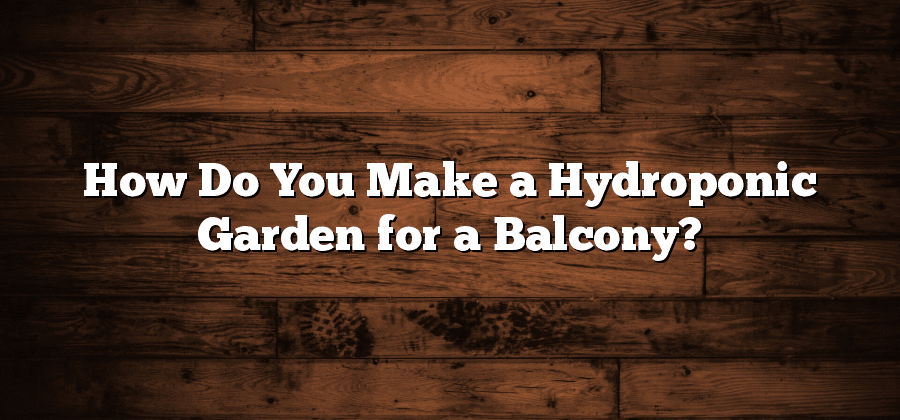Selecting the Right Hydroponic System for Your Balcony
Hydroponic gardening is becoming increasingly popular among urban dwellers who have limited space but still want to grow their own fresh produce. If you have a balcony and want to embark on this exciting gardening adventure, selecting the right hydroponic system is crucial to your success. A hydroponic system is essentially a method of growing plants without soil, using water and nutrients to nourish the plants’ roots. There are various types of hydroponic systems available, each with its own advantages and considerations.
One of the most common hydroponic systems for balconies is the drip system. This system utilizes a pump to deliver nutrient-rich water to the plants through a network of tubes and emitters. Drip systems are versatile and can be easily customized to suit the size and layout of your balcony. Another option is the ebb and flow system, which periodically floods the plants’ roots with nutrient solution and then allows it to drain away. This system is efficient and low-maintenance, making it ideal for those with busy schedules. Finally, the nutrient film technique (NFT) system involves a thin film of nutrient-rich water flowing over the plants’ roots, providing them with a constant supply of water and nutrients. The NFT system is compact and space-saving, making it perfect for balconies with limited space.
Optimal Placement for Your Hydroponic Garden
Finding the ideal placement for your hydroponic garden is crucial for its success. While hydroponic systems are versatile and can be set up in various locations, there are a few key factors to consider when selecting the optimal spot. Firstly, ensure that your chosen location receives ample sunlight throughout the day. Most plants require at least six hours of direct sunlight each day to thrive and grow. **Placing your hydroponic garden near a south-facing window or on a sunny balcony can provide the necessary light exposure for your plants**.
In addition to sunlight, it is important to consider temperature and ventilation. **Most hydroponic systems perform best in a temperature range of 65 to 75 degrees Fahrenheit**. Therefore, avoid placing your garden in areas that experience extreme temperature fluctuations, such as near drafty windows or heating vents. Adequate air circulation is also a crucial factor to prevent the buildup of humidity and to facilitate proper gas exchange for the plants. **Consider placing your hydroponic garden in a well-ventilated area or using additional fans to ensure proper air circulation**.
Choosing the Appropriate Containers for Hydroponic Gardening
When it comes to hydroponic gardening, selecting the appropriate containers is a crucial step in ensuring the success of your plants. The container you choose will not only house your plants but also provide the necessary support and space for their root systems to grow. One important factor to consider is the material of the container. Plastic containers are a popular choice as they are lightweight, durable, and resistant to corrosion. They also provide good insulation, helping to regulate the temperature of the nutrient solution. Alternatively, you may opt for containers made of materials such as fiberglass or clay, each with their own benefits and drawbacks. Fiberglass containers are lightweight and resistant to UV radiation, while clay containers provide excellent aeration for the roots.
Size is another essential aspect to consider when selecting containers for hydroponic gardening. The size of the container will depend on the specific plants you wish to grow, as well as the available space in your hydroponic system. It is important to choose a container that is large enough to accommodate the root system of your plants, allowing them to spread and grow properly. Keep in mind that inadequate space can lead to stunted growth and poor nutrient uptake. Additionally, consider the shape of the container. Some plants, such as tomatoes and cucumbers, require deep containers to support their extensive root systems, while others, like herbs or lettuce, can thrive in shallower containers. By carefully considering the material, size, and shape of your containers, you can create an ideal environment for your hydroponic plants to flourish.
Selecting the Right Growing Medium for Your Plants
When it comes to hydroponic gardening, the choice of growing medium is crucial to the success of your plants. The growing medium serves as a substitute for soil, providing plants with the necessary support, nutrients, and oxygen. There is a wide range of options available, and selecting the right one depends on various factors such as the type of plants you are growing, the size of your hydroponic system, and your overall goals and preferences.
One popular and widely used growing medium is *coconut coir*. Derived from the outer husk of coconuts, coconut coir is known for its excellent water retention properties, making it ideal for hydroponic systems. It provides a stable environment for root development and promotes healthy plant growth. Another viable option is *perlite*, a volcanic rock that is lightweight and has excellent drainage capabilities. Perlite helps to prevent the roots from becoming waterlogged and ensures proper oxygenation. Additionally, *vermiculite* is a good choice, particularly for plants that require more moisture retention, as it has superior water retention qualities. It also provides insulation to the roots in colder climates.
When choosing the right growing medium, it is essential to consider the specific needs of your plants. Some plants may thrive in a lightweight medium with enhanced drainage, while others may require a medium that retains more water. Experimentation and researching the requirements of your chosen plants will help guide you in selecting the most appropriate growing medium for your hydroponic garden.






